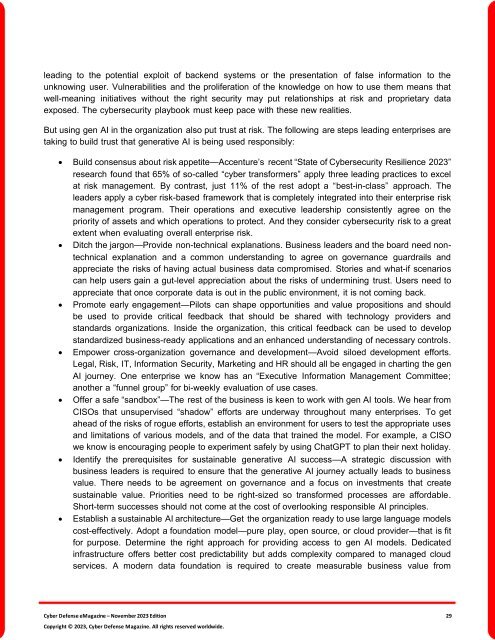The Cyber Defense eMagazine November Edition for 2023
Cyber Defense eMagazine November Edition for 2023 #CDM #CYBERDEFENSEMAG @CyberDefenseMag by @Miliefsky a world-renowned cyber security expert and the Publisher of Cyber Defense Magazine as part of the Cyber Defense Media Group as well as Yan Ross, Editor-in-Chief and many more writers, partners and supporters who make this an awesome publication! 196 page November Edition fully packed with some of our best content. Thank you all and to our readers! OSINT ROCKS! #CDM #CDMG #OSINT #CYBERSECURITY #INFOSEC #BEST #PRACTICES #TIPS #TECHNIQUES
Cyber Defense eMagazine November Edition for 2023 #CDM #CYBERDEFENSEMAG @CyberDefenseMag by @Miliefsky a world-renowned cyber security expert and the Publisher of Cyber Defense Magazine as part of the Cyber Defense Media Group as well as Yan Ross, Editor-in-Chief and many more writers, partners and supporters who make this an awesome publication! 196 page November Edition fully packed with some of our best content. Thank you all and to our readers! OSINT ROCKS! #CDM #CDMG #OSINT #CYBERSECURITY #INFOSEC #BEST #PRACTICES #TIPS #TECHNIQUES
Create successful ePaper yourself
Turn your PDF publications into a flip-book with our unique Google optimized e-Paper software.
leading to the potential exploit of backend systems or the presentation of false in<strong>for</strong>mation to the<br />
unknowing user. Vulnerabilities and the proliferation of the knowledge on how to use them means that<br />
well-meaning initiatives without the right security may put relationships at risk and proprietary data<br />
exposed. <strong>The</strong> cybersecurity playbook must keep pace with these new realities.<br />
But using gen AI in the organization also put trust at risk. <strong>The</strong> following are steps leading enterprises are<br />
taking to build trust that generative AI is being used responsibly:<br />
• Build consensus about risk appetite—Accenture’s recent “State of <strong>Cyber</strong>security Resilience <strong>2023</strong>”<br />
research found that 65% of so-called “cyber trans<strong>for</strong>mers” apply three leading practices to excel<br />
at risk management. By contrast, just 11% of the rest adopt a “best-in-class” approach. <strong>The</strong><br />
leaders apply a cyber risk-based framework that is completely integrated into their enterprise risk<br />
management program. <strong>The</strong>ir operations and executive leadership consistently agree on the<br />
priority of assets and which operations to protect. And they consider cybersecurity risk to a great<br />
extent when evaluating overall enterprise risk.<br />
• Ditch the jargon—Provide non-technical explanations. Business leaders and the board need nontechnical<br />
explanation and a common understanding to agree on governance guardrails and<br />
appreciate the risks of having actual business data compromised. Stories and what-if scenarios<br />
can help users gain a gut-level appreciation about the risks of undermining trust. Users need to<br />
appreciate that once corporate data is out in the public environment, it is not coming back.<br />
• Promote early engagement—Pilots can shape opportunities and value propositions and should<br />
be used to provide critical feedback that should be shared with technology providers and<br />
standards organizations. Inside the organization, this critical feedback can be used to develop<br />
standardized business-ready applications and an enhanced understanding of necessary controls.<br />
• Empower cross-organization governance and development—Avoid siloed development ef<strong>for</strong>ts.<br />
Legal, Risk, IT, In<strong>for</strong>mation Security, Marketing and HR should all be engaged in charting the gen<br />
AI journey. One enterprise we know has an “Executive In<strong>for</strong>mation Management Committee;<br />
another a “funnel group” <strong>for</strong> bi-weekly evaluation of use cases.<br />
• Offer a safe “sandbox”—<strong>The</strong> rest of the business is keen to work with gen AI tools. We hear from<br />
CISOs that unsupervised “shadow” ef<strong>for</strong>ts are underway throughout many enterprises. To get<br />
ahead of the risks of rogue ef<strong>for</strong>ts, establish an environment <strong>for</strong> users to test the appropriate uses<br />
and limitations of various models, and of the data that trained the model. For example, a CISO<br />
we know is encouraging people to experiment safely by using ChatGPT to plan their next holiday.<br />
• Identify the prerequisites <strong>for</strong> sustainable generative AI success—A strategic discussion with<br />
business leaders is required to ensure that the generative AI journey actually leads to business<br />
value. <strong>The</strong>re needs to be agreement on governance and a focus on investments that create<br />
sustainable value. Priorities need to be right-sized so trans<strong>for</strong>med processes are af<strong>for</strong>dable.<br />
Short-term successes should not come at the cost of overlooking responsible AI principles.<br />
• Establish a sustainable AI architecture—Get the organization ready to use large language models<br />
cost-effectively. Adopt a foundation model—pure play, open source, or cloud provider—that is fit<br />
<strong>for</strong> purpose. Determine the right approach <strong>for</strong> providing access to gen AI models. Dedicated<br />
infrastructure offers better cost predictability but adds complexity compared to managed cloud<br />
services. A modern data foundation is required to create measurable business value from<br />
<strong>Cyber</strong> <strong>Defense</strong> <strong>eMagazine</strong> – <strong>November</strong> <strong>2023</strong> <strong>Edition</strong> 29<br />
Copyright © <strong>2023</strong>, <strong>Cyber</strong> <strong>Defense</strong> Magazine. All rights reserved worldwide.

















